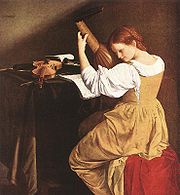
Kirtle
Encyclopedia

Tunic
A tunic is any of several types of clothing for the body, of various lengths reaching from the shoulders to somewhere between the hips and the ankles...
-like garment worn by men and women in the Middle Ages or, later, a one-piece garment worn by women from the later Middle Ages into the Baroque
Baroque
The Baroque is a period and the style that used exaggerated motion and clear, easily interpreted detail to produce drama, tension, exuberance, and grandeur in sculpture, painting, literature, dance, and music...
period. The kirtle was typically worn over a chemise
Chemise
The term chemise or shift can refer to the classic smock, or else can refer to certain modern types of women's undergarments and dresses...
or smock and under the formal outer garment or gown
Gown
A gown is a loose outer garment from knee- to full-length worn by men and women in Europe from the early Middle Ages to the 17th century ; later, gown was applied to any woman's garment consisting of a bodice and attached skirt.A long, loosely-fitted gown called a Banyan was worn by men in the 18th...
.
Kirtles were part of fashionable attire into the middle sixteenth century, and remained part of country or middle-class clothing into the seventeenth century.
Kirtles could be loose garments without a waist seam, or could be made as a combined bodice
Bodice
A bodice, historically, is an article of clothing for women, covering the body from the neck to the waist. In modern usage it typically refers to a specific type of upper garment common in Europe during the 16th to the 18th century, or to the upper portion of a modern dress to distinguish it from...
and petticoat
Petticoat
A petticoat or underskirt is an article of clothing for women; specifically an undergarment to be worn under a skirt or a dress. The petticoat is a separate garment hanging from the waist ....
, depending on their use and the current fashion. Kirtles typically laced up the back or side-back, especially when worn under front-lacing gowns as in sixteenth century Germany and the Low Countries.

